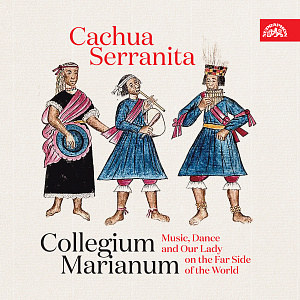Album

Jana Semerádová, Collegium Marianum
Cachua Serranita
Digital services
Hanaq pachap cussicuinin (hymn to the Virgin Mary, Lima 1631), Taye jueves Santo (Santa Cruz de la Sierra, 18th century), Cachua serranita (Codex Martínez Compa?ón, Peru, 18th century). Kristian Gottfried Hirschmentzel (1638-1703) - Moravica, Bohemicus saltus. Anonymous - Aria Hannaco. Georg Philipp Telemann (1681-1767) - Hanaquoise, Hanasky. Jan Josef Ignác Brentner (1689-1742) - Concerto da camera in F, Bourrée & Capriccio from Concerto in G. Domenico Zipoli (1688-1726) - Zuipaqui / Ad Mariam. Martin Schmid (1694-1772) - Pastoreta Ychepe flauta. Three Peruvian folk songs. Šla panenka smutně (Book of Haná dances for clavichord, ca 1700). Bohemian and Moravian folk melodies
Collegium Marianum: Jana Semerádová - flutes, artistic director; Vojtěch Semerád - Baroque violin and viola, percussion, vocals; Jiří Sycha - Baroque violin, charango, vocals; Marcel Comendant - cimbalom, percussion, Ján Prievozník - G violone
We have the concept of globalization associated with the 20th century, but without much exaggeration we can apply it to the Jesuit missions in South America in the 17th and 18th centuries. The Jesuits were aware of the power of music, which profoundly touches the human heart. The European music they brought across the ocean was in no time embraced by the indigenous peoples in Bolivia and Peru. And thus works by the Czech composer Josef Brentner, the Italian Jesuit Domenico Zipoli or the Swiss missionary Martin Schmid were soon performed in the settlements in the middle of the jungle and in the mountains. European music blended with the traditional local music, just as the Quechua language blended with Spanish. Through music and singing they praised God and prayed to the Virgin Mary, as we can hear in the Quechua procession hymn Hanaq pachap cussicuinin or Zipoli's Zuipaqui. However, similarly vivid instrumental music, songs and dances were enjoyed in Moravia, in the very heart of Europe. And again the globalisation in music: many a folk song and dance was imbued with elements of "high culture", and vice versa, G. P. Telemann did not hide enthusiasm and direct inspiration from Silesian and Haná folk music in his work. And songs worshipping the Mother of God were sung in spectacular churches, village chapels and fields alike. Yet whether European music was performed in the jungle or Haná melodies in Hamburg, the common denominator was enthusiastic musicians who knew no greater delight than getting together and playing. Just like Collegium Marianum on this recording. Let us rejoice together!
The unbridled joy of music. In Bolivia, Peru, Moravia. In the Baroque era and today alike.
Reviews
“It’s an intriguing musical palimpsest, a rich tangle of textures and influences… Languages, instruments and continents may change but the spirit of dance and song – communal ritual, celebration and recreation – remain the same, Collegium Marianum argue. Anyone tempted to disagree might want to try listening to this recording without tapping a toe or swaying a hip.”
Gramophone, April 2022
“The music on this delightful recording features both juxtapositions and fusions of rhythms and melodies from European cities and mountain regions, South American instrumentation, secular songs, and liturgical texts. The Collegium Marianum play these pieces with the perfect balance of lighthearted delight and devotional decorum, and the album should find a home in any library supporting the study of either early music or ethnomusicology.”
CD Hotlist, May 2022
“L’équipe nous livre ici une interprétation épicée et charismatique de cette anthologie stimulée tant par l’exotisme que par la fertilité des réseaux d’inspiration croisés entre l’ancien et le nouveau mondes.”
Crescendo, July 2022
|
Anonymous
|
|||
| 1. | Hanaq pachap cussicuinin | 04:30 | |
|
Kristián Gottfried Hirschmentzel
|
|||
| 2. | Moravica and Bohemicus saltus | 02:18 | |
|
Anonymous
|
|||
| 3. | Šla panenka smutně | 01:49 | |
|
Jan Antonín Losy, Anonymous
|
|||
| 4. | Aria Hannaco | 01:03 | |
|
Georg Philipp Telemann
|
|||
| 5. | Hanaquoise | 02:06 | |
|
Jan Josef Ignác Bretner
Concerto da camera D minor
|
|||
| 6. | Allegro staccato | 02:10 | |
| 7. | Largo | 01:03 | |
| 8. | Menuet | 01:07 | |
|
Anonymous, Domenico Zipoli
|
|||
| 9. | Zuipaqui / Ad Mariam | 04:12 | |
|
Jan Josef Ignác Bretner
|
|||
| 10. | Bourrée & Capriccio | 02:11 | |
|
česká lidová
|
|||
| 11. | Vyletěla holuběnka ze skály | 01:38 | |
|
Martin Schmid
Pastoreta Ychepe Flauta
|
|||
| 12. | - | 01:11 | |
| 13. | Allegro | 02:17 | |
| 14. | Adagio | 01:43 | |
| 15. | Allegro II | 01:27 | |
|
Anonymous
|
|||
| 16. | Taye jueves Santo | 03:30 | |
|
Georg Philipp Telemann
|
|||
| 17. | Hanasky | 02:45 | |
|
Anonymous
|
|||
| 18. | Three Peruvian Folk Songs | 04:07 | |
|
česká lidová
|
|||
| 19. | Na Svatém Kopečku | 03:43 | |
|
česká lidová
|
|||
| 20. | Když jsem já šel na Svatý Kopeček | 01:59 | |
|
Anonymous
|
|||
| 21. | Cachua Serranita | 03:16 | |